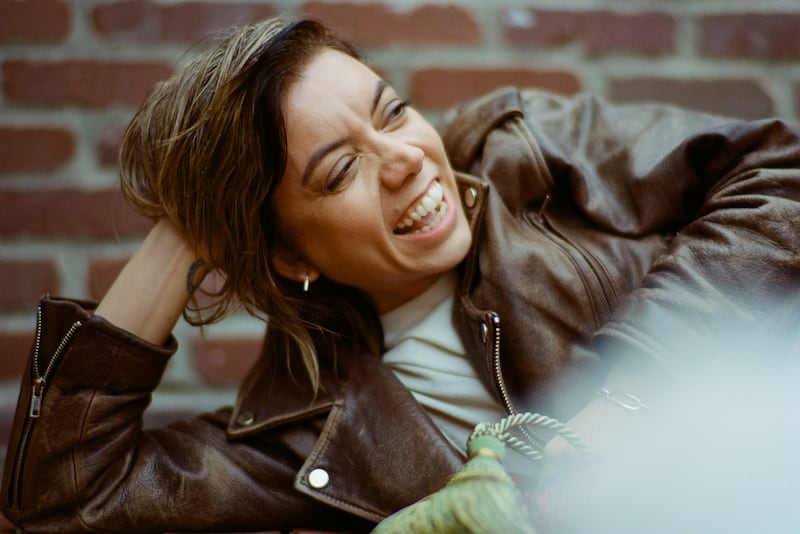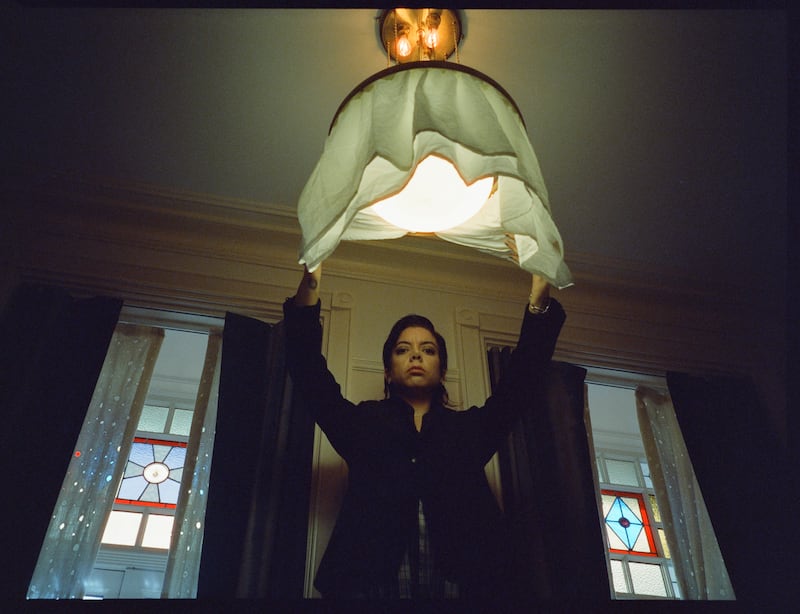Almost a year after the sudden death of Alynda Segarra’s father, the sight of a Bronx-bound subway entrance made the musician cry.
“I walked by the 1 train yesterday, and the colour of the red and the ‘1’ and the ‘Van Cortlandt Park’ and the ‘Uptown’ – I just burst into tears,” Segarra, who uses they/them pronouns, said. “I was just like, this is so crazy that I don’t really have a reason to go up there.”
Segarra, who is 36 and makes folk music with a punky defiance as Hurray for the Riff Raff, wore a distressed white tee under a fitted leather vest, and silver jewellery that matched their painted nails. Sipping a coffee on a zebra-print couch in a quiet nook of Manhattan’s Hotel Chelsea, Segarra compared the storied hotel’s decor to the sets of the Yorgos Lanthimos movie Poor Things. Staying at the Chelsea was an uncharacteristic extravagance, but since Segarra’s father’s death, the performer has been allowing for treats like these, in his honour.
“My dad loved enjoying,” Segarra said. “He just didn’t deny himself pleasure. So now I’m really starting to be like, ‘Why not?’”
Excuse My French restaurant review: An experience simply unlike anything else in Dublin
Ireland’s remote islands: Only 29 apply for €84,000 grant aimed at attracting residents
10 of the best new shows to watch in April: including Netflix medical drama and two AppleTV+ releases
MobLand review: Pierce Brosnan’s Irish accent is a horror for the ages. Forget licence to kill, this is more Darby O’Gill
Segarra, who is of Puerto Rican descent, was raised in the Bronx and left home at 17, first living in a Philadelphia squat and eventually relocating to New Orleans and busking in a motley hobo band called the Dead Man Street Orchestra. (“I couldn’t believe that it was real,” Segarra recalled with lingering delight. “I just get to sing Tom Waits songs and people give me money?”) When Louisiana got too hot or Segarra just got too restless, the musician would ride the rails, getting to know the United States through blurred glimpses of its vast landscape.
Some of those youthful adventures are recounted, with an overlay of maturity and melancholy, on The Past Is Still Alive, Segarra’s arresting, artfully autobiographical ninth album, which is now on release.
“I love that” – so deep into the singer-songwriter’s career – “they’re making their best work now,” said Brad Cook, who has produced the past two Hurray albums. “It’s just so cool to see somebody work that hard.”
Since self-releasing a first full-length album in 2008, Segarra has toured tirelessly and earned the admiration of contemporary artists such as Katie Crutchfield of Waxahatchee.
“If I were to be asked who I think is my peer who I respect most as a songwriter, I would say Alynda,” Crutchfield said in a phone interview. Speaking about Segarra’s 2017 folk epic The Navigator, she noted, “There’s a couple songs on that record that make every playlist I ever make”.
“I get a kind of Springsteen, us-against-the-world feeling”, from much of the music, Conor Oberst, the Bright Eyes frontman, said in an interview about Hurray for the Riff Raff.
“There’s this fighting spirit,” he added, “and world-weariness to a lot of the songs, but the delivery is so effortlessly, nonchalantly cool.” (Oberst sings with Segarra on a track from the new album.)
The Past Is Still Alive began gestating in 2022, when Segarra was opening for Bright Eyes. The pandemic had made touring more financially precarious than ever for independent musicians, and Segarra was feeling that uncertainty.
“It was so stressful,” the singer said. The price of gas had doubled. Physical sales had long since given way to streaming, which pays most artists pennies. “Behind the scenes I was like, ‘Oh, maybe I don’t have a career.’ Which felt really scary because I was like, I don’t know how to do anything else.”
But watching Oberst perform his sharp-witted folk-rock on tour inspired Segarra to do something unusual: write on the road.
“It was like a writing retreat,” Segarra said. “For me, it felt impossible not to write after listening to those lyrics every night.”
And eventually, those financial difficulties even became a creative spark.
“I think it helped to feel like ‘Maybe my career is over,’” Segarra said and laughed. “Because it helped trick my brain to be like, ‘This is just for me and my friends,’ you know? There’s not a lot to hide behind. The writing feels similar to how I wrote when I was 18, and the point was just to be as vulnerable as possible.”

In a 2008 New Yorker column about New Orleans street music, Segarra is mentioned playing banjo and washboard with a jazz ensemble called the Loose Marbles, who make music “that sound as if they were first performed in a hobo jungle during the Hoover administration”. In New Orleans Segarra became inspired by Delta blues, Appalachian folk and other formative American musical movements, leading the singer to romanticise the past: “I used to be like, Damn, I wish I was born in the ’60s.”
Small Town Heroes, the first Hurray for the Riff Raff album to gain wider recognition, came out in 2014, but its folksy sound made it seem as if it could have arrived just about any year in the 20th century. It gained traction in the nebulously defined but still somehow circumscribed world of Americana music, a label that stifled the more radical aspects of the performer’s vision, Segarra said.
“Americana as a genre has grown a lot since then,” Segarra said, “but at that time I actually felt unsafe being myself and being explicit in my ideas and beliefs.” The singer felt fetishised for being both Puerto Rican and queer, pressured to live up to the sanitised image of “a good ol’ gal who lives down in New Orleans”.
“I was editing myself – even the way I dressed and presented myself onstage,” they said. “I knew this was a big opportunity and I didn’t want to lose it. I didn’t want to become homeless again. I was really working from a lot of fear.”
Segarra’s 2022 album, Life on Earth, was, thematically and sonically, a reclaiming of the present.
“I really felt like they came out of their shell in such a powerful way during the making of that record,” Cook said. It contains elements and instruments not traditionally associated with Americana – synthesisers, near rapping – and also grapples openly with the heartbreak of climate change. “Oh, I might not meet you there,” Segarra sings on the elegiac title track. “Spirit blinded by despair.”
The Past Is Still Alive continues this acceptance of the present.
“I feel like I’m finally able to blend all these things,” Segarra said. “I’m able to play an acoustic guitar and sing a folk song but also speak in my own language and feel very comfortable being myself.”
The album’s finale is the staggering epic Ogallala, which culminates in Segarra singing, “I used to think I was born in the wrong generation, but now I know I made it right on time/ To watch the world burn, with a tear in my eye.”
“With the state of the world being in such chaos, I really do feel different. This is absolutely the right time for me to be alive, and writing songs. There’s no doubt in my mind any more.”

One of the most striking songs on the new album is Hourglass, a dirgelike meditation on memory and class disparities that finds Segarra making a raw admission: “I always feel like a dirty kid/ I used to eat out of the garbage.”
“That line was like, ‘Oh, I have no skin,’” Segarra said. It was partially about Segarra feeling self-conscious about being a high school dropout among tour mates who had gone to prestigious music colleges. When they brought Cook a demo of that song, Segarra was insecure about the bluntness of the language.
“I kind of thought it was just a voice memo,” Segarra recalled. Cook assured the singer that it was indeed a song, and a great one.
“I sort of love that Alynda doesn’t know that Hourglass is a song,” Cook said. “I love that Alynda doesn’t know how powerful and vulnerable and confident what they’re putting out there is. I don’t even think they realise how good they are.”
Since coming out as nonbinary before Life on Earth was released, Segarra has used music as a space to experiment more freely with gender. There’s a gleeful fluidity to the way that manifests on The Past Is Still Alive. Segarra sings about the pressure to “be a good daughter”, but also asserts, on Snake Plant, “I was born with a baby boy’s soul.”
On the album’s cocksure cover art, Segarra consciously channelled James Dean and River Phoenix.
“I wanted to embody one of these sad, pretty-boy-in-workwear American archetypes,” the singer said with a laugh. Queer elders who showed them how to transcend the gender binary make cameos throughout The Past. In Colossus of Roads, Segarra name-checks poet Eileen Myles, whose example taught them that “there’s also this option of existence, and creation of who you are.” (Myles happened to be in the audience of a small Hurray for the Riff Raff show in Marfa, Texas, and approached Segarra afterward to ask, “Did I hear my name, or am I just full of myself?”)
On a Wednesday evening in late January, about 100 people gathered at St Mark’s Church-in-the-Bowery to listen to an early playback of The Past Is Still Alive. At any given moment during the album’s 11 emotionally wrenching tracks, light sniffles could be heard. Loss, Segarra said in a Q&A afterward, had made the singer feel “like I needed to write all these people down. We have all these monuments to all these [expletives] around the country. This is my version of a monument.”
Segarra then picked up a guitar and played a stunning solo version of Alibi, the tough-loving leadoff track.
“You don’t have to die if you don’t want to die, you could take it all back in the nick of time”, Segarra sang in a rich alto that echoed from the rafters. Segarra initially wrote Alibi to a friend struggling with addiction but said it was one of many songs on the album whose meaning has transfigured in the wake of the death of the performer’s father.
“Singing that song after he passed, it just became about something else,” Segarra said. “Like, your spirit doesn’t have to die. You don’t have to leave me. You can stay with me if you want, you know?” – This article originally appeared in The New York Times.
2024 The New York Times Company












